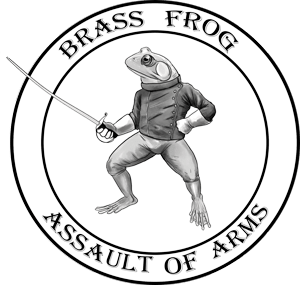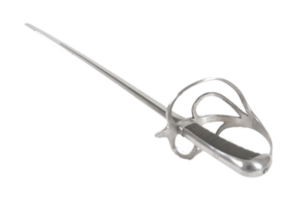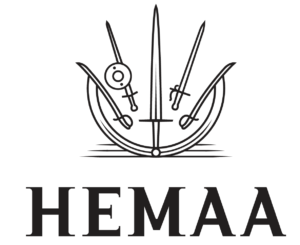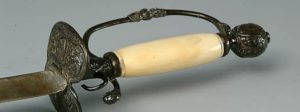2023
Pringle-Green’s Cutlass and Pistol – Scott Loescher
East Meets West: The Jiu-Jitsu of Alfred Hutton – Kyle A. Marrotte
Murder on the Back Beat – Ian Crowe
Bringing a Stick to a Knife Fight – Julie Olson
Scoundrels and Scallywags! – Patrick Bratton
Dance of the Whiskey Stick – John Borther and Trish Chiovari
HEMAA Instructor Certification
2022
Instructor: Ashley Sciandra and Scott Loescher
Spadroon stuff!
Instructor: Scott Loescher
Board and capture french ships the right way!
Instructor: Jeremy Steflik
Instructor: Patrick Bratton
Instructor: Julie Olson
Instructor: Nick Hinton
Instructor: Jason L. Cook
Instructor: Jeremy Steflik
2019: Introduction to Cerri Baton
Instructor: Julie Olson
Students will be introduced to Giuseppe Cerri’s Baton (two-handed stick) fighting method. While this weapon is regaining popularity in Europe as a sport “fencing” weapon, its roots are from peasantry self-defense. The class will teach the basics of the weapon, including movement, attacks, parries, and tactics against multiple opponents. If time allows, we’ll explore how to use this weapon against other types of weapons.
Bio: Julie Olson began studying German Longsword with Athena School of Arms in 2013. It was during attendance at Brass Frog 2015 that she was introduced to – and fell in love with – baton, and she is thrilled to be teaching this year! Julie has also dabbled in Italian Rapier, Broadsword/Military Sabre, and Dagger. Julie has received top-5 placements at a few regional/national tournaments, as well as Technical Excellence awards. She is one of the head instructors at Athena and Event Director for Iron Gate Exhibition.
2019: Dynamic Parries and False Edge Work in Hungarian Hussar Sabre
Instructor: Russ Mitchell
This class will provide a refresher on basic parries in the Hungarian system that Russ learned from Prof. Hidan Csaba, and then continue the class into dynamic parries (aka, what to do when the opponent changes lines mid-strike or you’ve misread the opponent’s intent), and on the various ways the false edge is deployed within the system.
As with last year, the emphasis with this instruction is on retention of material, not merely a whirlwind tour of “Sexy Fencing Tricks.” The class will assume that students either attended last year or reviewed the video materials available but is going to be “less ambitious” on paper in order to guarantee that there’s time to reinforce basics to the greatest degree possible, with additional material held in reserve to be taught pending the students’ ability to absorb and perform the material.
2019: German Sabre Peculiarities
Instructor: Jeremy Steflik
This class will explore the application of a set of techniques by examining not only how the the Berliner Turnschule deals with them, but also how they were used in other systems in the region.
Required equipment: Mask, jacket, elbow protection, appropriate gloves, training saber (steel, plastic wood) – the more curved the better.
2019: German Stoßfechten According to Kreussler’s Principles
Instructor: Jeremy Steflik
Wilhelm Kreussler developed a system of fencing in the early 17th century that dominated German thrust-fencing until the end of the 19th century. Aside from the Kreussler family dynasty, which included more than 20 Fencing Masters, his system was taught throughout the 19th century by two branches of the tradition: The Roux family and the Berliner Turnschule. In this class we’ll touch on the basics of German Stoßfechten according to principles established, but never written down, by Kreussler or his family. We’ll then look at a family of techniques that two contemporary Masters had very different views on, present both their cases, and let you decide on the usefulness.
2019: Footwork Explained
Instructor: Eddy Louis
In my lecture on Footwork, I’ll be teaching various styles of movement, and introducing the context in which one might employ them with a few examples to go home with. During the lecture I’ll introduce various exercises, and training tips to help build strong balance and fluidity in one’s fencing. When you leave the class you should have a grasp of the foundation of solid footwork, and how to self diagnose your movements so you can continue to improve on your own.
2018: The Joinville System of Baton
Instructor: Maxime Chouinard
The Joinville-le-Pont School of Gymnastics and Fencing opened during the Second French Empire n order to create a unified body of knowledge to teach physical skills to soldiers. This is where the famous Joinville style of French Baton was created in 1852. The Joinville system became one of the most popular military programs in the world, with its formula exported everywhere from the United -States to Japan. This class will cover the teachings found in the Manuel de Gymnastique as well as elements from masters who gravitated around the school.
2019: Introducing Monsieur La Boëssière
Instructor: Victor Markland
Arguably Smallsword had reached its zenith by about 1800. Most of the influential instruction manuals such as Angelo, Girard and others had been published years before. By the time “Treatise on the Art of Arms” is published in 1818 daily carry for civilians was passing out of style. However the memory of those we would think of as icons of the Golden Age of Smallsword lingered. Chief among these would be the legendary Chevalier Saint Georges.
We are fortunate to have in this text not only a detailed account of his longtime friend but the full course of training that Saint Georges undertook at the hands of the elder La Boëssière, the fencing master mostly remembered only as the inventor of the mesh fencing mask. La Boëssière’s method of teaching and the elegance and effectiveness they create has long deserved more attention. He emphasizes adherence to principles, speed and precision, opposition, attacks from distance, and taking advantage of your opponents lost time. It is that refined and demanding style and the unique interactive method of the elder La Boëssière that we will explore in this class. I can guarantee that by the end of the class you will know what it means to fence in the style of La Boëssière. I just cannot guarantee you will fence as well as Saint Georges.
2019: Introduction to Cavalry Sabre
Instructors: Patrick Bratton, and Nickolys Hinton
This class will look at the basics of cavalry sabre in two different time periods. Earlier Napoleonic sabre will be introduced using the 1795 Marchand British Dragoon Manual, then we will look at late 19th Century sabre from both the 1873 Italian Cavalry Regulations and Maisello’s 1897 Sabre Fencing on Horseback. It will give students a basic understanding of how sabre actions are different from horseback and how techniques changed over time. We plan on having horse simulators for people to try from.
2019: Up Close and Stabby with Meyer
Instructor: Andrew Kilgore
Joachim Meyer was a 16th century German Cutler and Fechtmeister who is attributed with at least three manuscripts covering a wide range of weapons. This class will examine the Dagger section of Gründtliche Beschreibung der Kunst des Fechtens (“A Thorough Description of the Art of Combat”). Students will be introduced to essential guards, techniques, and concepts that tie Meyer’s system together. Special attention will be given to broad martial concepts that can be applied across systems.
2018: Valville’s Franco-Russian Saber
Instructor: Maxime Chouinard
Alexandre Valville is a French fencing master who published a treatise on cut and thrust fencing in 1817’s Saint Petersburg. Valville was a product of Old Regime fencing, but is probably one of the most well-traveled masters of his era, having learned fencing not only in France, but also in the UK, Italy, Hungary, Germany and even took the time to learn a type of African double stick fighting. His method is unusual for the time, as it is closer to the more complex systems of the 17th and 18th centuries and presents many engaging guards not presented by other 19th century authors. In this class, we will take a look at some of Valville’s peculiarities including his guards, feints and voltes.
2018: Ernst Seidler’s 1843 Fechten mit dem Säbel
Instructor: Jeremy Steflik
The system described in Seidler’s 1843 manual evolved from German academic cut-fencing during French occupation of Prussia and treats the heavily curved m1811 light cavalry saber separately from the straight Kürassier sword. After a brief review of the system’s fundamentals we’ll explore several of the more advanced and unusual topics covered in the manual.
Required equipment: Mask, jacket, elbow protection, appropriate gloves, training saber (steel, plastic wood) – the more curved the better.
2018: Neapolitan Spada
Instructor: Patrick Bratton
Italian fencing in the 18th century is often overlooked as a forgotten period between the rapier of the 17th century and the classical foil of the 19th century. However, there are manuals from this time that show the changes in Southern Italian fencing from the late rapier of the 17th Century through the Neapolitan spada in the 18th and early 19th centuries, and then to classical foil and epee. This class will give an introduction to Neapolitan spade of Terracusa, Rosaroll and Grisetti, and reference to later texts like Parise. It will cover guard positions, variations of footwork, simple attacks and parries, and actions on the blade.
2018: Bartitsu Concepts
Instructor: Chris Gregurich
Bartitsu is a Historical European Art principal created by Edward Barton Wright in 1899. Bartitsu was a combination of Pugulism, Savate kicking, Jujitsu & Swiss wrestling, later incorporating Vigny La Cane, making this one of the first mixed martial arts. This class will cover the concepts of using these Arts as a whole element, not just cane fighting. So concepts of use of this system will be explained and taught.
Christopher has been studying Traditional and Historical Martial Arts for almost 30 yrs. He holds a 3rd dan in Kenpo karate and specializes in Historical and Modern Cane Arts such as Bartitsu, Cummingham, Irish Bata(Cuman Bahta). He has studied under Ken Pfregner and Antrim Bata under Danny Hoskins and Maxime, Filipino Kali base under the Detroit Dog Brothers group and Historical Western Arts with Dr. John Lennox.
2017
Hussar Military Sabre
Instructor: Russ Mitchell
This three hour workshop provides traditional instruction in Hungarian hussar sabre, with an emphasis on clearly distinguishing it from other lineages and making sure that students have enough mastery of the basic movements and principles of the system that they are able to retain it for private practice on their own afterwards. Gear required is minimal: any curved stick or practice sabre is acceptable. Protective gear may be worn as desired, but it is not required.
Russ Mitchell teaches a method of hussar military sabre and fokos (long-handled axe) which survived in in a “broken lineage” in 20th-century Transylvania. He consults for Boyovyi Hopak USA and has been involved with various WMA since the mid 1990s. Russ teaches privately and is the founder of “Great… Plains Sword and BBQ” a HEMA umbrella group based in the Dallas/Fort-Worth area.
Dueling Sabre Tactics
Instructor: Ken Mondschein
This three hour workshop, which assumes that students will already be familiar with the basic mechanics of cuts, thrusts, parries, moulinets, beats, engagements, and the lunge, will deal with how to attack the opponent while remaining safe oneself. Topics to be covered include: Use of engagement, feint,or action on the blade to close distance; finding the blade on recovery; time of the hand and time of the foot; tactical footwork; the half-advance; targeting the advanced target; second intention and countertime; indirect and compound ripostes; counterattacks and the feint in time; and both deploying and dealing with the point in line.
Binding with the Messer
Instructor: Christian H. Tobler
This 90 minute class will provide students with a grounding in how to play from the crossing of two swords, in this case, the falchion-like German messer. The principles trained here will however be applicable to all swords, and especially single-handed ones. Central to the decision-making process applied once the swords meet will be the precept of Fühlen (Feeling) – the reading of the opponent’s intent based upon the pressure they apply in the bind. Equipment: A steel messer or arming sword, a fencing mask, gloves Intensity level: Moderate
Fixed Bayonets!
Instructor: Jeremy Steflik
This class aims to introduce a simple system of bayonet fencing in use during the latter half of the 19th century. In this period of time the advancement of firearm technology led to the decline in the importance of the fixed bayonet as a battlefield weapon. Still, it was an important part of any infantryman’s training. We’ll be looking at the use of the longer socket bayonets affixed to rifled muskets, usually topping 72″ in total length. By the end of the class we hope you’ll agree with the assertions that the fixed bayonet is more formidable weapon than either the lance or the sabre, and that a well-trained infantry soldier has little to fear from a cavalry soldier!
Required equipment: Mask, jacket, gloves. A variety of Bayonet trainers will be provided. Additional torso protection is strongly encouraged.
Combination Attacks with the Highland Broadsword
Instructor: Christopher Scott Thompson
Christopher Scott Thompson is the author of several books dealing with Highland Swordsmanship. A resident of Portland, Maine, Thompson is the president of the Cateran Society, a national organization that promotes historical fencing with Highland weapons.
Meyer Dagger Fundamentals with some additional thoughts about structure for both Fiore and Meyer dagger techniques
Instructors: John O’Connor and Don Kindsvatter
Joachim Meyer’s dagger techniques include reliance on the dagger hand for defense which is a significantly different approach than that used by Fiore and others who rely on the empty hand to block an attack. This class will explore Meyer’s use of blocking and hooking in response to attacks in order to gain control of an opponent’s weapon and set up follow-on techniques. The class will cover responses to overhead attacks to the head and chest as well as lower attacks to the body; the use of the dagger in both icepick and saber grips and switching back and forth. The class will focus on drills to build timing and distance skills and included some structured sparing. Mask and gloves are required to participate.
2015
Fixed Bayonets!
Instructor: Jeremy Steflik
This class aims to introduce a simple system of bayonet fencing in use during the latter half of the 19th century. In this period of time the advancement of firearm technology led to the decline in the importance of the fixed bayonet as a battlefield weapon. Still, it was an important part of any infantryman’s training. We’ll be looking at the use of the longer socket bayonets affixed to rifled muskets, usually topping 72″ in total length. By the end of the class we hope you’ll agree with the assertions that the fixed bayonet is more formidable weapon than either the lance or the sabre, and that a well-trained infantry soldier has little to fear from a cavalry soldier!
Required equipment: Mask, jacket, gloves. A variety of Bayonet trainers will be provided. Additional torso protection is strongly encouraged.
Henry Angelo’s Scottish Broadsword Fencing
Instructor: Jonathan MacKenzie Gordon
Come learn the basics of the fearsome Highland Basket-hilted Broadsword and learn the fencing techniques of famed 18th Century Fencing Master Henry Angelo. This workshop will explore the footwork and cutting techniques of the Angelo system while getting an introduction to Angelo’s 10 Lessons of the Highland Broadsword, which is considered the foundation of basket-hilt fencing. There will also be an opportunity to handle other Scottish weapons such as the Claymore, the Targe and the dreaded Highland Dirk.
Equipment Required: Basket-Hilt Trainer or Equivalent (some will be provided), Fencing Mask, Jacket, and Gloves
Hope’s New Method of Swordsmanship
Instructors: Steven Hirsch
“No People in the World, have a swifter Hand in Thrusting, nor any, a more loose or uncertain Parade, than the French” – Sir William Hope, A New, Short and Easy Method of Fencing, Chap. IV
Disgusted with the prevalence of double hits in French dueling, Scotsman Sir William Hope created a new system of smallsword fencing; one intended be safer in the fight and easier to learn. Created around the turn of the 18th century, it is a simplified and conservative system. It is not as pretty but it is more secure. His system is also intended to work with a cutting sword such as a spadroon. This leads to a style equally suited to any contemporary sword. The class will introduce the key elements of this approach to the fight.
Minimum equipment is standard modern fencing gear; as well as a foil, epee or smallsword simulator. A light saber or spadroon is also acceptable. Loaner weapons will be available.
Grand Baton
Instructor: Ken Mondschein
This will be an introduction to the “Joinville” method of two-handed stick, the living descendent of longsword which is still taught traditionally. Subjects taught will include moulinets for offense and defense, methods of stiking, tactical drilling, and rules. This will be a light-contact class; students should bring a fencing mask or equivalent, stout but flexible gloves, body protection (minimum of a gambeson) and a shin protector.
Dragoon Saber on Foot
Instructor: Professor Mark P. Donnelly
One often sees tournaments advertised as “Heavy Saber” which indicates, in reality, that it is not lightweight dueling sabers (Radaelli, Pecoraro, etc). What these tournaments are really addressing are light infantry sabers in the manner of Hutton, et al.. Heavy sabers, on the other hand, certainly did exist for battlefield use and while commonly designed for light (flanking) cavalry were also taught for use on foot. This session, therefore, will focus on the use of dragoon saber on foot. Depending on time constraints, we will explore the use of saber in terms of technique and tactic as well as its use versus officer’s spadroon or fixed bayonet on foot.
An Introduction to the Gentlemanly Art of Bartitsu
Instructor: Professor Mark P. Donnelly
In 1898, Edward William Barton-Wright announced the formation of a “New Art of Self Defence”. This art, he claimed, combined the best elements of a range of fighting styles into a unified whole, which he had named Bartitsu (a portmanteau of his own name and jujutsu). Barton-Wright had previously also studied “boxing, wrestling, fencing, savate and the use of the stiletto under recognized masters”, reportedly testing his skills by “engaging toughs (street fighters) until (he) was satisfied in their application.” He defined Bartitsu, therefore, as meaning “self defense in all its forms”.





